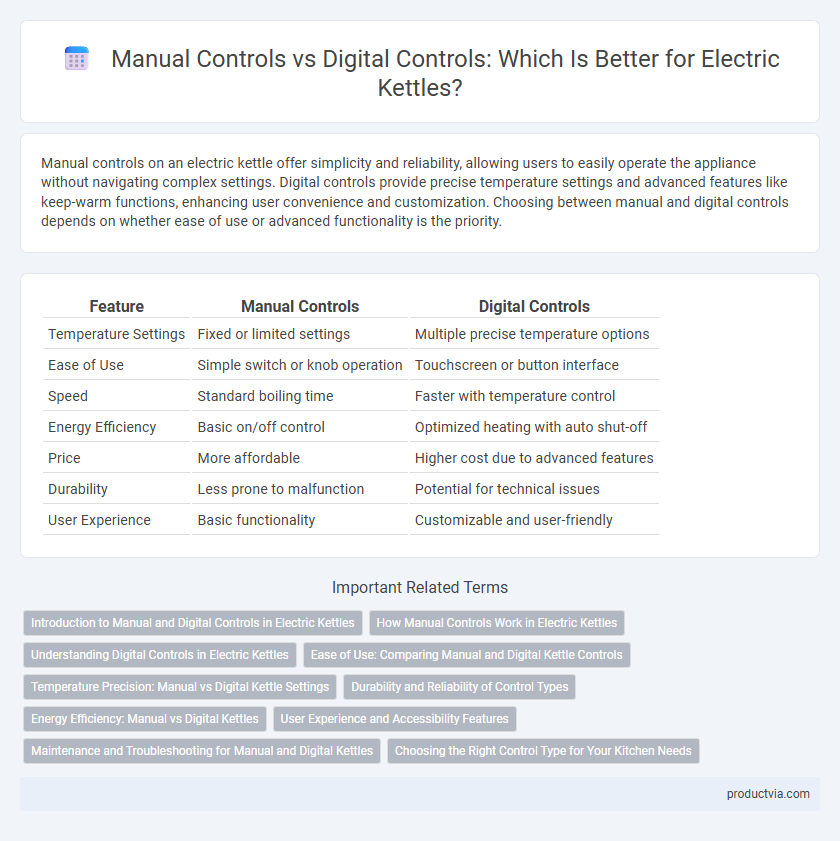Manual controls on an electric kettle offer simplicity and reliability, allowing users to easily operate the appliance without navigating complex settings. Digital controls provide precise temperature settings and advanced features like keep-warm functions, enhancing user convenience and customization. Choosing between manual and digital controls depends on whether ease of use or advanced functionality is the priority.
Table of Comparison
| Feature | Manual Controls | Digital Controls |
|---|---|---|
| Temperature Settings | Fixed or limited settings | Multiple precise temperature options |
| Ease of Use | Simple switch or knob operation | Touchscreen or button interface |
| Speed | Standard boiling time | Faster with temperature control |
| Energy Efficiency | Basic on/off control | Optimized heating with auto shut-off |
| Price | More affordable | Higher cost due to advanced features |
| Durability | Less prone to malfunction | Potential for technical issues |
| User Experience | Basic functionality | Customizable and user-friendly |
Introduction to Manual and Digital Controls in Electric Kettles
Manual controls in electric kettles offer straightforward operation through physical switches or dials, providing reliable temperature setting without the need for complex interfaces. Digital controls enhance precision and convenience by enabling exact temperature adjustments, programmable settings, and often include LCD displays for real-time feedback. Choosing between manual and digital controls depends on user preference for simplicity versus advanced functionality in electric kettle operation.
How Manual Controls Work in Electric Kettles
Manual controls in electric kettles typically use mechanical switches or knobs to regulate power and temperature settings, enabling direct user input without electronic interfaces. These controls rely on physical components like toggle switches or rotary dials to initiate heating and control water boiling processes. The simplicity of manual controls enhances durability and reduces malfunction risks compared to digital systems.
Understanding Digital Controls in Electric Kettles
Digital controls in electric kettles allow precise temperature settings and programmable functions, enhancing user convenience and accuracy. These controls often include LED displays and customizable presets for different types of beverages, improving the overall brewing experience. Unlike manual controls, digital systems support advanced features such as keep-warm modes and automatic shut-off timers, contributing to energy efficiency and safety.
Ease of Use: Comparing Manual and Digital Kettle Controls
Manual controls on electric kettles offer straightforward operation with simple buttons or switches, making them intuitive for users who prefer quick, no-fuss functionality. Digital controls provide precise temperature settings and programmable features, enhancing convenience for brewing specific beverages like tea or coffee. While digital models offer greater customization, manual kettles excel in ease of use due to their simplicity and immediate responsiveness.
Temperature Precision: Manual vs Digital Kettle Settings
Manual controls on electric kettles offer basic temperature settings typically limited to boiling point or preset temperatures, resulting in less accurate temperature control. Digital controls provide precise temperature adjustment with exact degrees, enabling users to select specific temperatures for different beverages such as green tea or coffee, enhancing brewing quality. The enhanced temperature precision in digital kettles improves energy efficiency and ensures optimal flavor extraction, making them preferable for tea connoisseurs and coffee enthusiasts.
Durability and Reliability of Control Types
Manual controls for electric kettles typically offer greater durability due to their simple mechanical switches, which are less prone to malfunction from electrical faults or software glitches. Digital controls, while providing precise temperature settings and advanced features, can be more susceptible to wear and electronic failures over time. Choosing a kettle with manual controls enhances long-term reliability, especially in environments with frequent use or power fluctuations.
Energy Efficiency: Manual vs Digital Kettles
Manual electric kettles typically consume less energy due to their straightforward operation, as they boil water without extra functions that increase power usage. Digital kettles offer programmable settings like temperature control and keep-warm timers that optimize energy usage by preventing over-boiling and reheating. Energy efficiency in digital kettles often surpasses manual models when smart features are used correctly, reducing overall electricity consumption.
User Experience and Accessibility Features
Manual controls on electric kettles offer straightforward operation with tactile buttons or switches, enhancing accessibility for users with visual impairments or limited dexterity. Digital controls provide precise temperature settings and programmable features, improving user experience through customization and convenience but may require a learning curve. Balancing ease of use and advanced functionality depends on user preferences and accessibility needs, making it crucial to select kettles that align with individual capabilities and daily routines.
Maintenance and Troubleshooting for Manual and Digital Kettles
Manual electric kettles typically require simpler maintenance due to fewer electronic parts, making troubleshooting straightforward by inspecting physical components like the switch or cord. Digital electric kettles involve complex circuitry and sensors, demanding specialized knowledge for maintenance and often requiring professional repair for electronic malfunctions. Regular descaling is essential for both types, but digital kettles may also need software updates or resets to resolve control panel issues.
Choosing the Right Control Type for Your Kitchen Needs
Manual controls for electric kettles offer straightforward operation with physical switches or dials, ideal for users who prefer simplicity and durability. Digital controls provide precise temperature settings, programmable features, and often include LCD displays, making them suitable for tea enthusiasts and tech-savvy kitchens. Selecting between manual and digital controls depends on your priorities for ease of use, customization, and budget, ensuring the kettle matches your specific kitchen routine and preferences.
Manual controls vs digital controls for electric kettle Infographic

 productvia.com
productvia.com